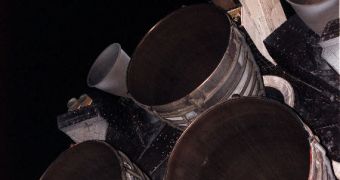Officials at the American space agency announce that it conducted the last test firing of a reusable solid rocker motor for the space shuttle, at a Promontory, Utah-based facility. With only four shuttle flights remaining before the space fleet is scheduled to be retired, this September, reaching this milestone makes a lot of people nostalgic at the thought of what this program managed to accomplish over the years. These new tests, which are the last ever to be conducted under the new policy guidelines set for NASA by the Obama Administration, were successful, and met all criteria, the experts add.
The flight support motor (FSM-17) was fired for about 123 seconds, which is precisely the amount of time it would need to function in the event of it being outfitted on the external fuel tank, during a live shuttle launch. Full results of the testing procedures have yet to be published, but engineers say that preliminary conclusions seem to indicate that the engine burnt its fuel within parameters, and that it produced the exact amount of thrust it was supposed to. An upcoming NASA report will deal with all the technical details of the new test firings.
The solid rocket motors that are used during shuttle launches are produced and tested just north of Salt Lake City, by ATK Launch Systems, which is a division of Alliant Techsystems Inc. On February 25, the company ran its 52nd test for NASA in more than three decades. Testings here began in July 1977, and thus far 129 space flights using these motors were launched to space successfully. “Today's test was a great deal more than the successful conclusion to a series of highly successful NASA/ATK-sponsored static tests that began more than three decades ago,” says the NASA Reusable Solid Rocket Booster project manager David Beaman, who is based at the agency' Marshall Space Flight Center, in Huntsville, Alabama.
“These tests have built a base of engineering knowledge that continued engineering development of the reusable solid rocket motor system and the continued safe and successful launch of space shuttles. They have provided an engineering model and lessons learned for additional applications in future launch systems,” the official adds. “During space shuttle flights, solid rocket motors provide 80 percent of the thrust during the first two minutes of flight. Each motor, the primary component of the shuttle's twin solid rocket boosters, generates an average thrust of 2.6 million pounds and is just over 126 feet long and 12 feet in diameter,” a statement on NASA's official website states.

 14 DAY TRIAL //
14 DAY TRIAL //